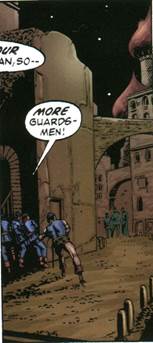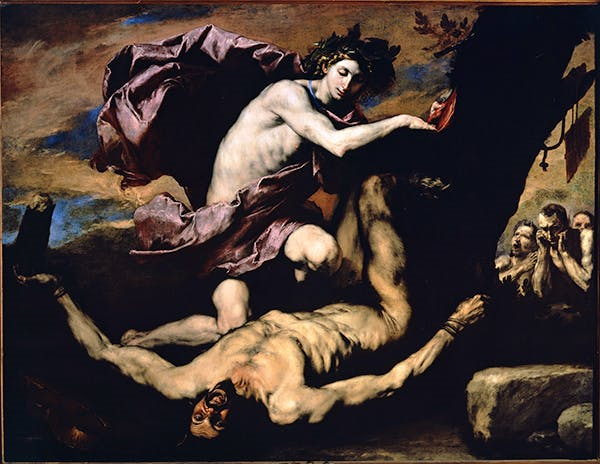
We’re back with the unplanned underclass of city-states, a gathering as of animals at an oasis, boisterous and free. On the other side of the equation are the monuments erected by the city-elders (Hyborian Bridge 19,20). Always there is a tension between freedom and order, a classical theme which harks back to Conan #7 and the inhuman beauty of “The God in the Bowl”(Weird 15)

© Marvel 1970
A face so calm, so serene masks a terrible truth – the body of a serpent. Pure order cannot exist; in classical myth Apollo is ever vying with the lustful gaiety of Dionysus, a theme of Euripides’ The Bacchae – see CH3
Always the calm beauty of Apollo masks something which is not gentle, the calm face of vengeance and ferocity

Apollo and Marsyas by Ribera – the sungod flaying the satyr for failing a music test
Order and calm are mere masks which cannot exist by their own light, as it is a type of death. The pure order that those at CERN are searching for merely masks disproportionate lusts born of freakish ego worship.
The wild and animal side of human nature is traditionally welcomed by those well-born individuals who are of rural, country house origins (Gainsborough Hyborian Bridge 15). I couldn’t help noticing in X-Men: First Class, James McAvoy has those mannerisms off to a tee. The initial meeting of Xavier as a kid with Raven is a choice encounter
X-MEN FIRST CLASS
That film is full of choice themes. Apart from the 60s Cuban stuff, you could easily make a case that McAvoy plays an aristocratic gentile to Fassbender’s more hard-bitten Jew. Both are up against the inhuman tyranny of Sebastian Shaw’s Hellfire Club. The animal high spirits of the trainee X-Men is a good counterpoint.
The calm insanity of inhuman order is always opposed by a type of intriguing balance, since that’s what human culture is composed of historically. As a way of digging myself out of X-Men, the Kulan Gath arc from #s 190-191 features Manhattan being turned into a Hyborian-style city-state, and I picked-out a few choice bits.
Ororo says in # 191
I am myself again. Except I know now.. that self is a lie
Earlier, crossing the mystic barrier she expresses it even more forcefully
I am myself again, but I was no less before. A monstrous lie..yet the truth! (#190)
Kulan Gath dislocates Manhattan Island in time, transposing the heroes’ outward appearance into “their equivalent historical analogues” (Val, page 4). The reason it works so well – as Ororo is able to grasp – is that the lie is also a truth – a truth of a different time. It wouldn’t be so grotesque – it could even be groovy – were it not that Kulan Gath’s monstrous personality is tyrannising the entire population for his own vengeful ends.
Quoting Val again (#190 page 5)
Within his barrier a different set of natural laws apply. Magic – sorcery – works.. His laws are enforced by a cadre of superbeings called Morlocks.
So, in order to enforce a tyrannical rule, what’s needed are laws that directly relate to the tyrant as a figurehead of the novel reality. He (or she) in a sense IS the reality; in their person is the raison d’etre for the illusory system.
I guess you see where this is heading? What’s needed is a figure who is held by all and sundry to be of a higher echelon, a peerlessness that cannot be gainsaid. The system then relates to this figure and – for the sake of argument - is a system of pure order. It dislocates time into ultra-precision - or the endless “circle” motif of Alphaville - while the faces of “calm insanity” are our dear leaders.
The calm order, of course, represents the head dislocated from the body. The worship of ego and abstract reason dislocated from time, as it is experienced by the body. That is, in time, rhythmic, proportionate. The dislocated world has to have a figurehead, and I think you know who I mean. Everything “they” say is truth is in fact a lie, but (as Ororo says) also a truth of this dislocated reality.
Without balance, the distortions of time and space mask the disproportion of human nature, a “calm insanity” (to quote John Clifton Weird 8), one that places the head on a plateau of material satisfaction. Everything in that satisfaction is a truth born of a lie – the dislocation of time and space from the proportionate body.
The head is dislocated from the slow and easy rhythms of seasons and harvest moon that are the lifeblood of the primal body. We then live in a disproportionate reality (of the head) that can appear truthful owing to the system itself – the spacetime continuum or mirror-image that is a convincing reflection (sun).
Yes, but rhythms do not lie. See the Song of Sonja and listen to the gentle lyrical lightness of “She’s Not There”; imagine the bloodrise dawn on rolling hills of dew-beaten grasslands, on and on
DREAM ON
A psychosis of the ego that does not live in the rhythms of space and time (of the body); a mirror-image; a gross distortion of the proportionate head (8 to the ideal figure – including the head.)
The head is in a trap of its own making. There it sits atop the slender neck, without which it would drop dead, and it cannot contemplate the perfection of sinuous rhythm and graceful proportion that emanates from the throat in song (Pictorial 1)
I’m not saying everything is rhythm, I’m saying the perfection of grace exists in time, and in that way we survive - as historically humans – not through any theory, however complicated or abstruse. Out of sheer elegant perfection comes the gaiety and splendour of color, feast, carnival that exist in time and are proportionate. The repercussions of this are universal.
A life on the range, the sounds and stenches of cattle in the dirt and dust, the rhythms of riding and steering. A horse is a pulsating powerhouse of rhythmic walking (clip-clop), trot, canter, gallop, a perfection of steaming effort that takes place in time and not in any theory known to Man, like music.
Where you have perfection, a type of loose gaiety arises (yeehaw!) The filth and wet and ragged costumes are part of the tenor of the life. Because the modern head is not attached to rhythm, it tends to develop a type of aversion to the natural squalor of wilderness living, even though the smells and dirt are just the other side of the equation to cleanliness (Pictorial 21).
Just as there is no pure order, there is no pure cleanliness, just a type of sterile death. Cleanliness, like most natural activity, is a case of balance and ritual. Stripped of the rituals – things that take place in time – Man is detached from his own body, from the unthinking gaiety of living as a beast. What is gaiety but simply letting things happen with no real forethought, treading the vine, swinging the tomahawk? And what is that but spirit? What are spirits but ghosts of place and time?
As a final intrusion into X—Men (you’ll be delighted to hear) #193 has one of Claremont’s moralising tales featuring the Apache James Proudstar, vengeful brother of Thunderbird. Having failed to slay Kitty and Logan, to regain his honor he must go for Xavier, who he believes to be the cause of his brother’s death.

X-Men #193 © Marvel
Tales of honor and giri are endlessly fascinating for the reason that it is something outside oneself – the relations, the ancestors – the ghosts of the earth who are to be avenged or to whom blood-sacrifices are to be made. The reality essentially is the opposite to the reality of the material world, being the psychic strength of the dead. If you recall, BWS’s Adastra in Africa (Tales of Faith 2) uses the psychic bond between living and dead in a tribal village, and the blood-sacrifice that traditionally placates the gods.
The physical reality of the African village nurtured by votive offerings. Another way to put it is place and time also harbour magic – the ghosts that thrive in BWS’s tree of life and death. Cycles of time and space are a main theme of a lot of BWS’s 70s prints (“The Enchantment” Weird 11), and those who say “inscrutable medievalism” are missing the point. We live and we die and there is both melancholy and gaiety. Those who deny any of that are in their own heads and not their bodies of graceful motion.
We are a graceful species and not a disembodied ego. The ghosts of time and space are ours to rediscover.

Home







